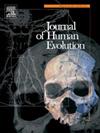对黄种人颅内表面的再分析:与现存大样本原始人的比较
IF 3.1
1区 地球科学
Q1 ANTHROPOLOGY
引用次数: 0
摘要
自发现以来,黄氏头盖骨的自然内蕴在解释人类大脑进化中发挥了核心作用。对达特来说,包括月骨沟的识别、顶叶可能的扩张和圆形轮廓在内的内骨骼特征表明,陶人与人类而不是其他类人猿灵长类动物是一致的,但这些解释立即引起了争议,直到今天仍然如此。我们已经生成了一幅详细的陶氏脑脊膜的曲率图,以参考189只黑猩猩和20只人类的大脑来评估它的表面组织。这些数据使我们能够从进化的角度考虑凹陷和突起的表面细节,足以标记初级脑沟和由于邻近脑回之间的浅表桥而导致的脑沟组织的变化。我们的研究结果表明,陶氏脑内皮层的月状沟在枕叶和顶叶下叶之间显示了一个回状桥,在65%的成年人大脑半球中可见,但在黑猩猩的大脑半球中仅占1.8%。陶氏脑内皮层的额叶组织反映了92.8%的成人大脑半球中出现的额上沟模式,但在成年黑猩猩样本中只出现了0%;成年人类大脑半球中100%出现了额下沟模式,但在黑猩猩样本中只出现了2.1%。黄种人的额下回保留了一个额眶沟,这个沟在0%的成人大脑半球和100%的成年黑猩猩大脑半球中都有。这些观察结果有助于解决对陶氏标本后内腔的一些明显不一致的解释,同时表明该标本与人类共享一些在黑猩猩中没有发现的内腔组织的衍生方面。本文章由计算机程序翻译,如有差异,请以英文原文为准。
A reanalysis of the Taung endocranial surface: Comparison with large samples of living hominids
Since its discovery, the natural endocast of the Taung cranium has played a central role in the interpretation of human brain evolution. Aspects of the endocast including the identification of the lunate sulcus, possible expansion of the parietal lobe, and rounded profile suggested to R. Dart that the Taung individual was aligned with humans and not with other anthropoid primates, yet these interpretations were immediately controversial and remain so today. We have generated a detailed curvature map of the Taung endocast to evaluate its surface organization with reference to 189 chimpanzee and 20 human brains. These data enable evolutionary consideration of the surface detail of depressions and projections sufficient to mark primary sulci and variations in sulcal organization due to superficial bridges between adjacent gyri. Our results suggest that the lunate sulcus in the Taung endocast displays a gyral bridge between the occipital lobe and the inferior parietal lobule seen in 65% of our adult human brain hemispheres but in only 1.8% of our chimpanzee ones. The frontal lobe organization of the Taung endocast reflects a superior frontal sulcus pattern seen in 92.8% of our adult human brain hemispheres, but in 0% of our adult chimpanzee sample, and an inferior frontal sulcus pattern seen in 100% of our adult human brain hemispheres but in only 2.1% of our chimpanzee ones. The Taung inferior frontal gyrus retains a fronto-orbital sulcus which is seen in 0% of our adult human brain hemispheres and in 100% of our adult chimpanzee ones. These observations help to resolve some apparent inconsistencies of interpretation of the posterior endocast of the Taung specimen while showing that the specimen shared some derived aspects of endocast organization with humans that were not found in chimpanzees.
求助全文
通过发布文献求助,成功后即可免费获取论文全文。
去求助
来源期刊

Journal of Human Evolution
生物-进化生物学
CiteScore
6.30
自引率
15.60%
发文量
104
审稿时长
3 months
期刊介绍:
The Journal of Human Evolution concentrates on publishing the highest quality papers covering all aspects of human evolution. The central focus is aimed jointly at paleoanthropological work, covering human and primate fossils, and at comparative studies of living species, including both morphological and molecular evidence. These include descriptions of new discoveries, interpretative analyses of new and previously described material, and assessments of the phylogeny and paleobiology of primate species. Submissions should address issues and questions of broad interest in paleoanthropology.
 求助内容:
求助内容: 应助结果提醒方式:
应助结果提醒方式:


